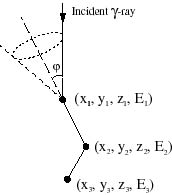Measurement Principle
How to Image Gamma-Rays
A telescope is popularly imagined to be a visual device used to observe things far away using mirrors and lenses. However, when the photons exceed energies of ~ 100 keV (called gamma-ray photons and 100,000 times greater than the energy of an optical photon), such direct methods of imaging become increasingly difficult. As a result, several indirect methods have been developed to image gamma-ray photons.
- "Coded Mask" Telescope: a position and energy sensitive detector with an opaque mask in front, applying the principle of a pinhole camera. See the COMPTEL homepage for more details.
- Compton Telescope: reconstruction of the photon direction using position and energy sensitive detectors based on the kinematics of Compton scattering. See the COMPTEL homepage for more details.
- Pair-Production Telescope: at high energies (~10 MeV to several tenths of GeV), the electron-positron pair generated from an incoming gamma-ray is tracked, determining both the gamma-ray's energy and direction. See the EGRET homepage for more information.
The Compton telescope concept is the most promising in the MeV energy range, where there is a deficit of energy for matter creation and an excess of energy for immediate photoelectric absorption, leaving Compton scatterings as the primary interaction.
Principle of the Compton Measurement

In the MeV energy range, photon-matter interactions are dominated by Compton scatterings. In a Compton scatter, an energetic photon collides with an electron, ejecting the electron from its orbit and being consequently deflected from the loss of energy and momentum. This photon continues its journey, possibly causing more Compton scatterings, until photoabsorption. The electron, having an electric charge unlike the photon, undergoes a series of collisions until it too loses all energy.
The image on the left shows how a Compton scattering can be used to restrict the point of origin of the gamma-ray. The incident gamma-ray collides with an electron at coordinates x1, y1,z1, transferring an energy of E1 immediately after collision. Similar information is obtained for other Compton interactions and is used to reconstruct the event with Compton kinematics. The angle j of deflection determined by this computation is revolved around a projection of the new direction, bounding the gamma-ray's possible point of origin.
For more information, please go to Imagine the Universe! - Compton Scatter.
Want to find out how this information is being used? Then go to LXeGRIT instrument.
Want to find out the science possible with such a telescope? Then go to Scientific Motivation.
